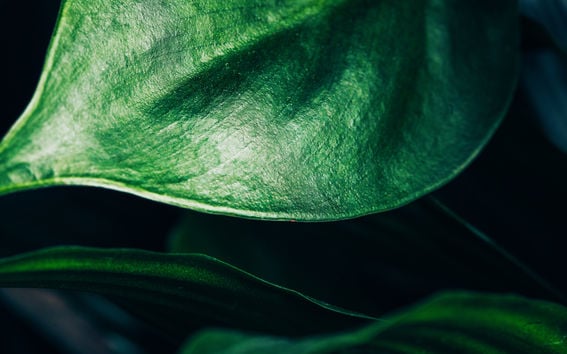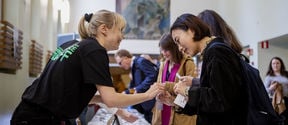The next material revolution will start in the forest

At the startof the year, the EU published its first-ever plastics strategy. It is based on the circular economy and related statistics, which indicate the urgency of a change in the culture of material utilization.
More than 25 million tonnes of plastic waste is produced in Europe each year. Less than a third is recycled, while the rest ends up as unsorted landfill waste or in the environment. 84% of the waste found on our beaches is plastic, and disposable goods like cotton buds, plates, drinking straws and forks account for the majority of this. The EU is now planning a total ban on such products in order to reduce the burden that plastics pose to the environment.
“Most plastics are fairly insensitive to moisture, which is part of the reasons for their long-life and persistence nature,” says VTT Technical Research Centre of Finland Research Professor Kristiina Kruus.
Kruus will assume the deanship of the School of Chemical Engineering in December 2018. She heads the new Academy of Finland-funded flagship project FinnCERES together with Aalto Professor Orlando Rojas. One goal of this multimillion-euro investment is to challenge plastics with new, plant-derived materials, including those from lignocellulose. This is a major challenge, since plastics do have their strengths – and a considerable advantage for now.
Separate and build
The mass production of synthetic plastics began in the 1950s. Since then, a whopping 8.3 billion tonnes have been manufactured. Today, plastics are produced at a rate twenty times higher than in the 60s. Their popularity is easy to understand as plastics are waterproof, light and malleable, and are made from cheap raw materials derived from crude oil.
“The amount invested in related infrastructure is so enormous that it is unrealistic to expect production to be wound down in the immediate future,” Kruus acknowledges.
Side-stream hydrocarbons create the building blocks of plastics: long and strong synthetic polymer chains consisting of thousands of molecules. For their part, lignocellulose biopolymers are created in the photosynthesis process through the interaction of sunlight, water and carbon dioxide, and they constitute the three main structural components of lignocellulose: cellulose, hemicellulose and lignin.
“Our idea is to separate the constituent parts while preserving their polymeric structures, and then use these parts to engineer materials with entirely new properties,” Rojas says.
This is already a familiar idea from papermaking, where wood fibres are first separated from one another and then mixed with water to form a slurry, which is then turned into paper after filtration, pressing and drying. Rojas and his colleagues want to go much further and, through novel separation and assembly strategies, to create functional biomaterials.
Fibers, for example, can be deconstructed into nano- and micro-scaled objects, including nanocelluloses and nanolignins. In turn, they exhibit some typical features as those displayed by other nanomaterials, including a high reactivity and surface area. Such properties can be used in water purification, to remove harmful substances like pharmaceuticals and hormones or for air
filtration. Assembly of colourless cellulosic nanomaterials in a specific way can result in coatings displaying vivid colours like those from the wings of butterflies, namely, structural colours. New functions, beyond colour, can emerge from such structures, which can be put to use.
“We will go beyond the concept of ‘replacing plastics’. We already have materials that function just as well, we want to develop properties that are unique to biopolymers. FinnCERES offers a materials paradigm shift,” says Rojas.
Nature’s own composite
The plastics industry of Europe alone generates more than €300 billion in annual turnover. Transitioning from the plastics age to the era of biologicals would revolutionise the structures of industry and the economy – in a way that is beneficial for Finland. There is no oil in Finland, but 78% of our land area is covered by forest, and the amount of biomass keeps growing each year.
“Finland has more forest biomass per capita than any other European country and we’re close to the top also on the global scale,” says Research Manager Katariina Torvinen of VTT.
Finland exports some €14 billion worth of forest-based bioproducts each year. VTT calculates that the value of exports could up to double by 2050 by developing added-value products. This would boost GDP by around three percent. Strong growth like this would require Finland to become more than just a producer of wood pulp, but instead process biomass further into high value-added products.
The microplastics problem has already boosted the demand for cellulose fibres, and the search is on to develop alternatives to plastics also in the composite and packaging sectors. Torvinen predicts that the next item to be banned by the EU will be polystyrene, better known as Styrofoam.
“In the USA, a few states have already banned its use. We’ve developed a technology that makes it possible to process biomass into a fibre-foam, which can replace Styrofoam. In addition, it can be used as heat and sound insulation in buildings, for example.”
More than 300 million tonnes of plastics are produced annually in the world, while pulp production totals some 200 million tonnes. It is therefore not possible to replace all plastics, nor is it the goal to do so, the researchers say. The smart choice is to utilise lignocellulose in products for which its natural properties are best suited.
Resilience and multi-functionality are some of the features in lignocelluloses. Lignocellulose is already a marvellous composite material.
“By evolution, the architecture of lignocelluloses in trees allows them to withstand storms, winds, flooding, heat, light and pathogens. From the strength point of view, wood can be processed to make bulletproof materials,” Orlando Rojas says.
“Plastics are lifeless, made from fossil carbon, with no function on its own, unlike living materials that evolve to adapt to stresses of all types. These are the structures we want to learn from and to exploit, wisely and sustainably.”
FinnCERES – the biomaterials competence cluster
- Academy of Finland-funded flagship project, which brings together
the close research cooperation of Aalto University and VTT with industry as well as national and international research networks. - Based on scientific excellence, unique infrastructure and high impact.
- Develops new bio-based materials for industrial-scale manufacturing for the international markets. These materials could be utilised both in everyday living and for industry: textiles, household goods, air and water purification systems, next-generation catalysts, ultralight transports and energy recovery systems.
- The Academy of Finland has granted FinnCERES about €9 million in funding for the next four years. One-fifth of this will be spent on realising fresh openings suggested by the research community.
Text: Minna Hölttä. Photo: Aleksi Poutanen.
This article is published in the Aalto University Magazine issue 23 (issuu.com), October 2018.
- Published:
- Updated:
Read more news

Robotics needs safe behavior patterns
Robotics and autonomous systems are developing rapidly. Algorithms that withstand disturbances and uncertainties in the system model and environment are critical for development.Understanding climate warming impacts on carbon release from the tundra
Tundras could transform from carbon sinks into a carbon source, exacerbating the effects of climate change
Program now available for the sustainability event of the year - Speakers include economist Kate Raworth and president Tarja Halonen
This year, Sustainability Science Days, a joint event of Aalto University and the University of Helsinki is collaborating with the world's largest Sustainability Research and Innovation Congress SRI. The event will bring together 2,000 experts to solve global sustainability challenges.